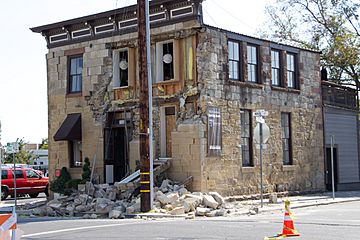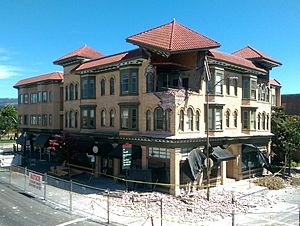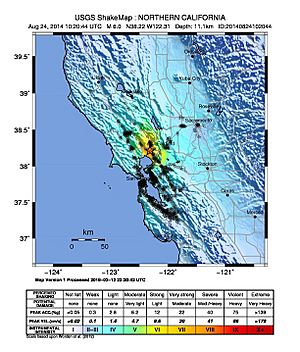2014 South Napa earthquake facts for kids

Damage to the Sam Kee Laundry Building
|
|
| UTC time | 2014-08-24 10:20:44 |
|---|---|
| ISC event | 610572079 |
| USGS-ANSS | ComCat |
| Local date | August 24, 2014 |
| Local time | 03:20:44 PDT (UTC-7) |
| Magnitude | 6.0 Mw |
| Depth | 7 mi (11 km) |
| Epicenter | 38°13′N 122°19′W / 38.22°N 122.31°W |
| Fault | West Napa Fault |
| Type | Strike-slip |
| Areas affected | North Bay (San Francisco Bay Area) California, United States |
| Total damage | $362 million–$1 billion |
| Max. intensity | VIII (Severe) |
| Peak acceleration | 0.61 g |
| Casualties | 1 killed about 200 injured |
The 2014 South Napa earthquake happened in the North San Francisco Bay Area on August 24, 2014, at 3:20 AM. It was a strong earthquake, measuring 6.0 on the moment magnitude scale. It caused severe shaking, reaching an intensity of VIII (Severe) on the Mercalli intensity scale. This was the biggest earthquake in the San Francisco Bay Area since the 1989 Loma Prieta earthquake. Its center was near Napa, on the West Napa Fault.
The earthquake caused a lot of damage, costing between $362 million and $1 billion. Sadly, one person died, and about 200 people were hurt. Interesting things happened during this earthquake. An experimental earthquake warning system gave scientists a few seconds warning. Also, water levels in springs and wells changed for a while.
Contents
How Earthquakes Happen
The San Andreas Fault System is a very active area in California. It is made of many strike-slip faults. These faults move sideways past each other. The West Napa Fault is part of this large system. It helps transfer movement between other faults nearby. Scientists study these faults to understand how often they move.
The Main Earthquake Event
The main earthquake had a strength of 6.0. It happened about 11.3 kilometers (7 miles) deep. The United States Geological Survey (USGS) estimated that many people felt the shaking. About 15,000 people felt severe shaking. Over 100,000 felt very strong shaking. The earthquake lasted for 10 to 20 seconds.
At least twelve smaller earthquakes, called aftershocks, followed. One of these was a magnitude 3.9. This earthquake was the largest in the Bay Area since 1989. Because of the damage, Governor Jerry Brown declared a state of emergency. Later, President Obama also declared a major disaster for the affected areas.
Damage Caused by the Quake
Many old buildings in downtown Napa were badly damaged. Even some that had been made safer for earthquakes showed signs of harm. Famous buildings like the Goodman Library and the Napa County Courthouse Plaza were hurt. The Sam Kee Laundry Building also had serious damage.
Several historic homes were also damaged. The Uptown Theater was closed because of ceiling damage. Six major fires started, and four homes were destroyed in a mobile home park. Firefighters had trouble because a water pipe broke. In Vallejo, many windows broke and walls cracked.
After inspections, 613 buildings were tagged. This means they were marked for safety. 113 buildings were "red-tagged," meaning they were unsafe to enter. 500 were "yellow-tagged," meaning they had limited entry. Roads in Napa, Solano, and Sonoma Counties also cracked.
Officials quickly estimated the damage at $362 million. Some early estimates suggested it could reach $1 billion. Many wineries, like Hess Collection and Trefethen Vineyards, had damaged buildings. Wine storage places also lost property. Later, the estimated damage to the wine industry was lowered to $80-$100 million.
A month later, the City of Napa reported more details. 156 commercial and residential buildings were red-tagged. 1398 were yellow-tagged. The city's own infrastructure, like water pipes and roads, needed $57.9 million in repairs. This included fixing 144 water mains and 294 damaged streets.
Injuries from the Quake
About 200 people were treated for injuries at a hospital in Napa. Most injuries were cuts and scrapes from falling things. Thirteen people needed to stay in the hospital. In Vallejo, 49 people were hurt. One person sadly died on September 5 because of injuries from the earthquake.
Getting Back to Normal
Many historic buildings damaged by the earthquake have been fixed. Others are still waiting for repairs. The Uptown Theater was the first to reopen in November 2014. The First Presbyterian Church reopened in July 2016 after $850,000 in repairs. The United Methodist Church also reopened after $2.2 million in upgrades.
The Goodman Library is expected to be finished with repairs in early 2018. The U.S. Post Office building was too expensive to fix. It was sold and will become a hotel. The Napa County courthouse is also being restored. The Trefethen Vineyard Eschol building was restored after more than two years of work.
Water Changes After the Quake
The earthquake caused a big, but temporary, increase in water flow in several nearby streams. These included Carriger Creek and Sonoma Creek. Also, water levels in some wells in the Sonoma Valley suddenly rose. In one case, a well's water level went up by 5 feet.
Fault Movement After the Quake
Geologists studied the earthquake's effects. They warned that the fault might continue to move slowly. This slow movement is called "afterslip" or "fault creep." It could cause the ground to shift up to 6 inches over the next three years.
Early Warning Systems
An experimental earthquake warning system called ShakeAlert detected the earthquake's first waves. This system, developed by the Berkeley Seismological Laboratory, sent a warning. It gave scientists in Berkeley about five seconds warning before the stronger, more damaging waves arrived. This means the warning was issued after the strong waves had already reached Napa and Vallejo.
A private company had also installed warning systems at fire stations in Vallejo. These systems opened bay doors about 1.7 to 2.4 seconds before the strong waves hit.
Earthquake warning systems are very important. They could give people time to take cover and prevent injuries. They could also automatically stop trains or shut off gas lines. The ShakeAlert system is being developed to cover the entire West Coast of the United States. It needs funding to become fully operational. In 2014, the United States Congress approved $5 million to help develop the system further.
|
See also
 In Spanish: Terremoto del sur de Napa de 2014 para niños
In Spanish: Terremoto del sur de Napa de 2014 para niños



